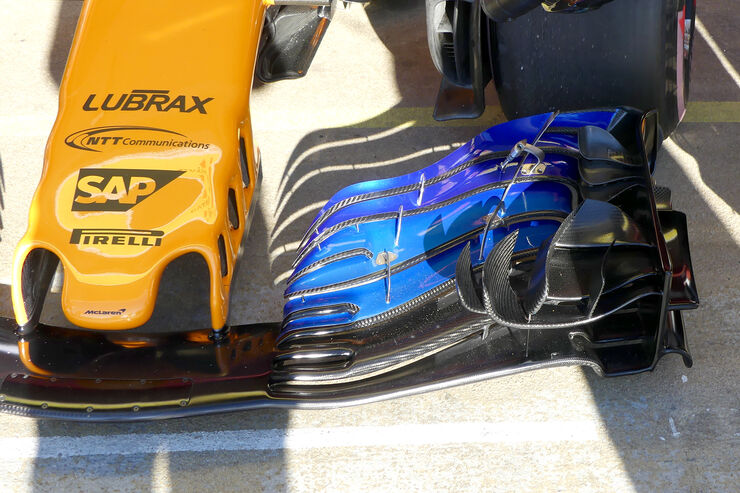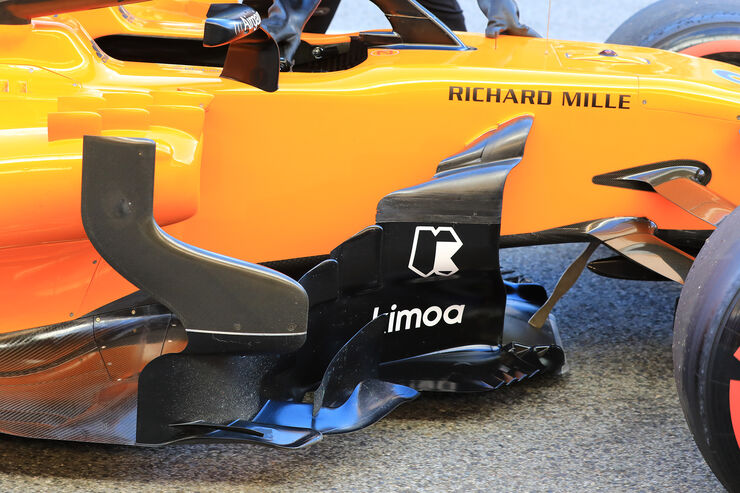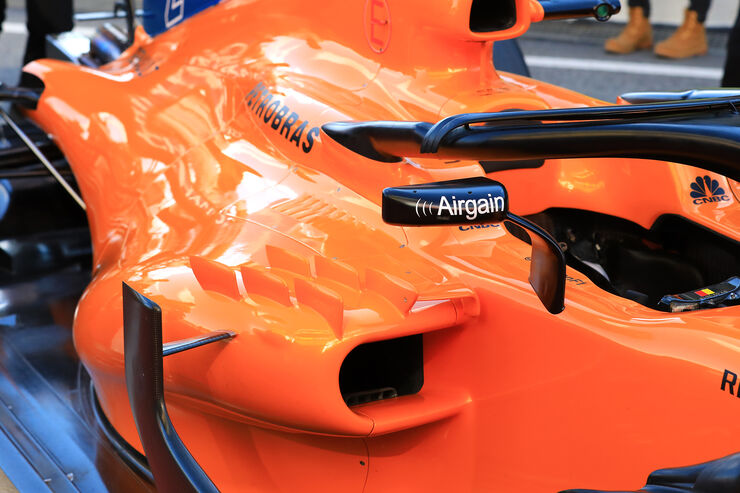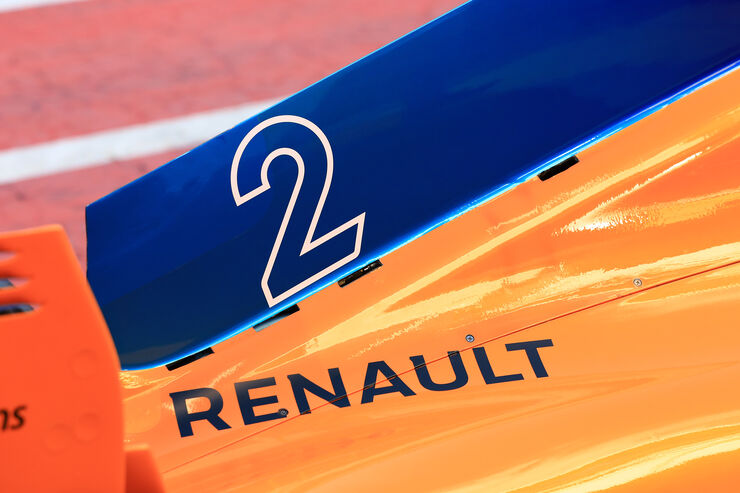- Login or Register
No account yet? Sign up
Is this from an article or??? How beneficial would it be? Any other team exploiting this?mclaren111 wrote: ↑03 Mar 2018, 08:16TJ13: 2018 Rules:
Hope it works !!Front axle
Ferrari started it. Red Bull, Renault and McLaren have mimicked it. The geometry of the front axle was designed in such a way that the front of the car was lowered in accordance with the steering angle. This ensured that the front wing edges closer to the track, while cornering, which generates more downforce. Since this clearly has an impact on aerodynamics, the FIA put a stop to this technique. Today a car, at a 12 degrees steering angle, isn’t allowed to sink forward more than five millimeters. This will be measured on a purpose build platform.
But experts believe that this ground clearance changes more on the racetrack than it does on the measurement platform, if you just do it skillfully. They think that the geometry of the front suspension of the new McLaren MCL33, which substantiates this suspicion with its extreme placement of the push-rods, is build with such a trick in mind. Charlie Whiting has already commented that if they see that the steering angle in reality exceeds 12 degrees, they will modify the test.
I read it on TheJudge13's post. I was not sure how reliable or legit that news it then I realized that TJ13 essentially copy pasted that from AMuS and changed the wording a bit and I think the wording is misleading.trinidefender wrote: ↑05 Mar 2018, 08:58There has been talk of McLaren's front suspension.
From what I can understand, continuing on from last year, teams used the suspension geometry to lower the front of the car when steering lock is applied. Can anyone fill me in on what exactly is going on or what it is hypothesised to do differently?
Or any pictures that demonstrate this effect or able to point it out on the suspension geometry?
That's all fine and well, just what I am trying to get at is what about the suspension geometry allows this. All the articles I read say the extreme pushrod angle...however as far as I can tell, the pushrod angle isn't going to have an effect on the geometry as the wheels move will it?makecry wrote: ↑05 Mar 2018, 10:04I read it on TheJudge13's post. I was not sure how reliable or legit that news it then I realized that TJ13 essentially copy pasted that from AMuS and changed the wording a bit and I think the wording is misleading.trinidefender wrote: ↑05 Mar 2018, 08:58There has been talk of McLaren's front suspension.
From what I can understand, continuing on from last year, teams used the suspension geometry to lower the front of the car when steering lock is applied. Can anyone fill me in on what exactly is going on or what it is hypothesised to do differently?
Or any pictures that demonstrate this effect or able to point it out on the suspension geometry?
https://www.auto-motor-und-sport.de/for ... pfloecher/
https://thejudge13.com/2018/03/02/fia-c ... loopholes/
It's because the pushrod is mounted to the part of the wheel that actually steers/turns, not to the suspension arms.trinidefender wrote: ↑05 Mar 2018, 20:29That's all fine and well, just what I am trying to get at is what about the suspension geometry allows this. All the articles I read say the extreme pushrod angle...however as far as I can tell, the pushrod angle isn't going to have an effect on the geometry as the wheels move will it?
Again, the front suspension is not aggressively high, as with the MCL32, which is better for mechanical grip than aero. Although McLaren’s push rod set up retains the clever geometry used last year. The pushrod is the diagonal suspension member that transfers the loads from the wheel into the springs\dampers mounted inside the chassis.
Rather than mount this to the lower suspension arm, most teams mount it to the upright that steers with wheel. This way the suspension can be affected by steering, usually giving an anti-roll effect. McLaren and other teams have tried a more extreme geometry with the pushrod spaced a long way from the steering axis and aligned so that the ride height changes with steering.
Over the Winter the FIA issued a clarification that more than 5mm of ride height change with steering is not allowed. This was aimed at these extreme pushrod-on-upright designs. McLaren must therefore have arranged theirs so as not to exceed the 5mm change with steering.
New parts are not allowed duringtranquility2k4 wrote: ↑05 Mar 2018, 20:51Any pics of new parts tested during the filming day today?

Interesting. Something else I've noticed is a seeming lack of steering arm....unless I'm just blind and missed it completely. Did they somehow hide the steering arm in on of the suspension wishbones?Jef Patat wrote: ↑05 Mar 2018, 21:10It's because the pushrod is mounted to the part of the wheel that actually steers/turns, not to the suspension arms.trinidefender wrote: ↑05 Mar 2018, 20:29That's all fine and well, just what I am trying to get at is what about the suspension geometry allows this. All the articles I read say the extreme pushrod angle...however as far as I can tell, the pushrod angle isn't going to have an effect on the geometry as the wheels move will it?
Rather than trying to explain it myself I'm going to refer to our beloved Craig:
https://drivetribe.com/p/f1-the-mclaren ... 5NxvKyUXEQ
Again, the front suspension is not aggressively high, as with the MCL32, which is better for mechanical grip than aero. Although McLaren’s push rod set up retains the clever geometry used last year. The pushrod is the diagonal suspension member that transfers the loads from the wheel into the springs\dampers mounted inside the chassis.
Rather than mount this to the lower suspension arm, most teams mount it to the upright that steers with wheel. This way the suspension can be affected by steering, usually giving an anti-roll effect. McLaren and other teams have tried a more extreme geometry with the pushrod spaced a long way from the steering axis and aligned so that the ride height changes with steering.
Over the Winter the FIA issued a clarification that more than 5mm of ride height change with steering is not allowed. This was aimed at these extreme pushrod-on-upright designs. McLaren must therefore have arranged theirs so as not to exceed the 5mm change with steering.











